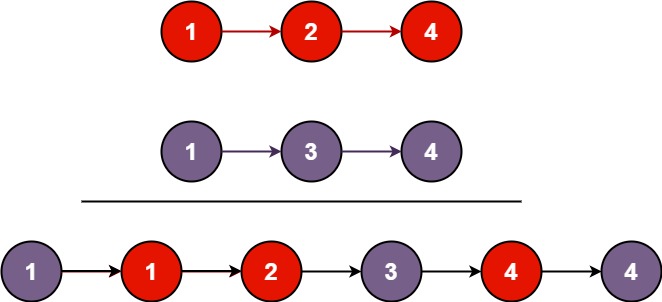21. Merge Two Sorted Lists
You are given the heads of two sorted linked lists list1 and list2.
Merge the two lists in a one sorted list. The list should be made by splicing together the nodes of the first two lists.
Return the head of the merged linked list.
Example 1:

Input: list1 = [1,2,4], list2 = [1,3,4]
Output: [1,1,2,3,4,4]
Example 2:
Input: list1 = [], list2 = []
Output: []
Example 3:
Input: list1 = [], list2 = [0]
Output: [0]
Constraints:
- The number of nodes in both lists is in the range
[0, 50]. -100 <= Node.val <= 100- Both
list1andlist2are sorted in non-decreasing order.
solution:
Following is the c++ solution of the above problem :
/**
* Definition for singly-linked list.
* struct ListNode {
* int val;
* ListNode *next;
* ListNode() : val(0), next(nullptr) {}
* ListNode(int x) : val(x), next(nullptr) {}
* ListNode(int x, ListNode *next) : val(x), next(next) {}
* };
*/
class Solution {
public:
ListNode* mergeTwoLists(ListNode* list1, ListNode* list2) {
ListNode*list3 = new ListNode();
ListNode*temp = list3;
while(list1 != NULL && list2 != NULL)
{
if(list1->val == list2->val)
{
list3 ->next = list1;
list1 = list1->next;
list3 = list3->next;
list3->next = list2;
list2= list2->next;
list3 = list3->next;
}
else
if(list1->val > list2->val)
{
list3->next = list2;
list2= list2->next;
list3 = list3->next;
}
else
{
list3->next = list1;
list1 = list1->next;
list3 = list3 ->next;
}
}
while(list1 != NULL)
{
list3->next = list1;
list1 = list1->next;
list3 = list3 ->next;
}
while(list2 != NULL)
{
list3->next = list2;
list2= list2->next;
list3 = list3->next;
}
return temp->next;
}
};
Comments
Post a Comment